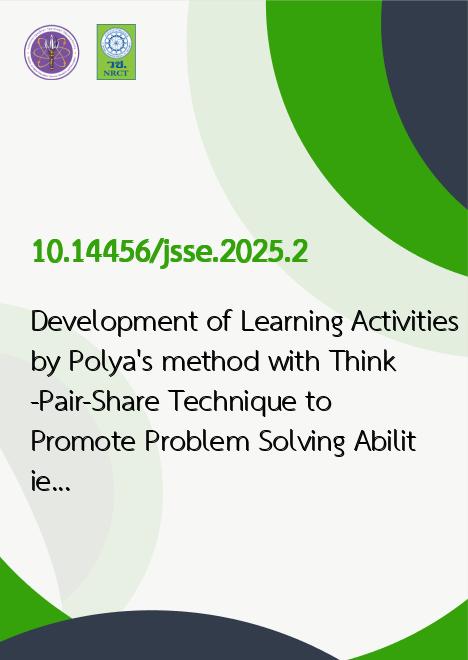
|
Development of Learning Activities by Polya’s method with Think-Pair-Share Technique to Promote Problem Solving Abilities for Grade 7 Students |
|---|---|
| รหัสดีโอไอ | |
| Creator | Tanyalak Nilakhot |
| Title | Development of Learning Activities by Polya’s method with Think-Pair-Share Technique to Promote Problem Solving Abilities for Grade 7 Students |
| Contributor | Maliwan Phattarachaleekul, Nipaporn Chutiman |
| Publisher | Faculty of Science, Ubon Ratchathani University |
| Publication Year | 2568 |
| Journal Title | Journal of Science and Science Education |
| Journal Vol. | 8 |
| Journal No. | 1 |
| Page no. | 14-23 |
| Keyword | Polya’s problem solving process, Think-Pair-Share technique, problem solving abilities, Academic achievement |
| URL Website | https://so04.tci-thaijo.org/index.php/JSSE/ |
| Website title | Journal of Science and Science Education |
| ISSN | 2697-410X |
| Abstract | The purposes of this study were: (1) to develop learning activities on linear equations with one variable in mathematics using Polya’s method with Think-Pair-Share technique to promote problem solving abilities to meet the efficiency criterion of 75/75, (2) to find the Effectiveness Index of learning through linear equations with one variable in mathematics using Polya’s method with Think-Pair-Share technique to promote problem solving abilities, and (3) to compare the mathematical achievement and problem-solving ability of students who after learning through on linear equations with one variable in mathematics using Polya’s method with Think-Pair-Share technique to promote problem solving abilities to 75 percent of criteria. The participants in this study were eighteen students who studied in Grade 7 at Dongnoiwittaya School in the second semester. However, they were selected by using cluster random sampling. The research instruments were (1) mathematics learning activities on linear equations with one variable in mathematics using Polya’s method with Think-Pair-Share technique to promote problem solving abilities plan, (2) the learning achievement test, and (3) the mathematical problem-solving ability test. The statistics for data analysis are percentage, mean, and standard deviation. Moreover, to examine the hypothesis by using a Hotelling’s T2. The results of the study were as follows: (1) the lesson plans for the organization of mathematics learning activities using Polya’s method with Think-Pair-Share technique was 83.23 /80.19, respectively, (2) the effectiveness index of plans for organizing mathematics learning activities of Polya’s method with Think-Pair-Share technique was 0.6871, indicating that the student’s scores increased by 68.71 percent, respectively, and (3) mathematical achievement of students who studied cooperative learning using Polya’s method with Think-Pair-Share technique meet the specified criteria at .05 level of significance and mathematical problem-solving ability of student technique meet the specified criteria at .05 level of significance. |